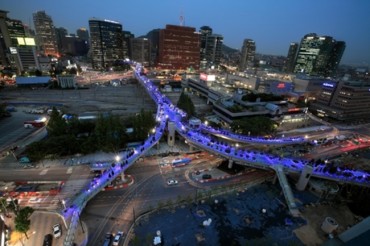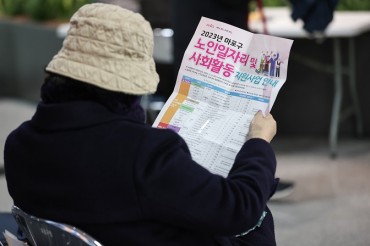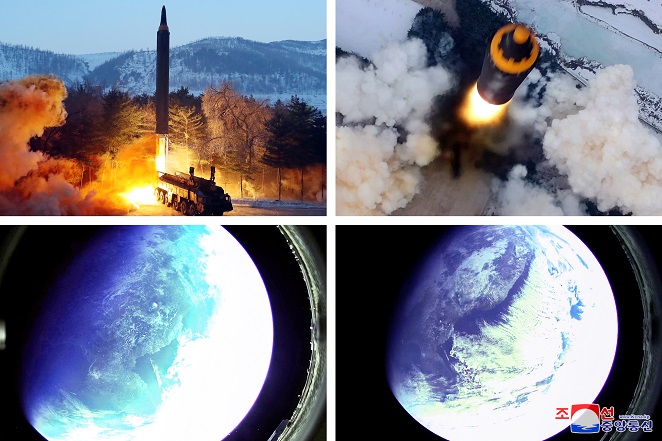
This composite photo, released by North Korea’s official Korean Central News Agency, shows its intermediate-range ballistic missile, Hwasong-12, being launched on Jan. 30, 2022. (Yonhap)
SEOUL, Jan. 31 (Korea Bizwire) — North Korea’s weekend launch of an “intermediate-and long-range” ballistic missile underscores the intransigent regime’s stated arms buildup in progress under a go-it-alone approach and its eagerness to tighten internal solidarity ahead of key political events, analysts here said Monday.
In its seventh show of force this year, Pyongyang launched the Hwasong 12-type missile Sunday, just days ahead of the Beijing Olympics and despite dialogue overtures by Seoul and Washington.
The latest launch came as North Korean leader Kim Jong-un is apparently intent on whipping up national pride ahead of major holidays — the 80th birthday of his late father, Kim Jong-il, on Feb. 16 and the 110th birthday of his late grandfather Kim Il-sung on April 15, the analysts said.
The North’s saber-rattling has posed an unsettling setback for Seoul striving to salvage its fragile peace drive, Washington preoccupied with tensions between Russia and Ukraine, and Beijing setting the mood for its successful hosting of the Winter Olympics set to begin Friday.
“The North appears to be moving under its own timelines for its weapons development projects unveiled at the eighth ruling party congress last year and for its major political events,” a security expert said on condition of anonymity.
“Internal factors appear to have much influence on its course of action.”
Amid a protracted deadlock in nuclear talks with the United States, the North has been doubling down on the five high-stakes defense projects it put forward at the eighth congress of the ruling Workers’ Party in January last year.
The projects include developing a hypersonic warhead, raising the “hit rates” of missiles with the range of 15,000 kilometers, producing a “super-large” nuclear warhead and developing an intercontinental ballistic missile (ICBM) using an “underground or ground solid-fuel engine.”
At the congress, the North also stressed the need to develop tactical nuclear weapons, and secure a nuclear-powered submarine and a nuclear strategic weapon capable of being launched underwater as it castigated the “military threat from the U.S.”
Evidence has been mounting that the North has been trying to accomplish those projects.
Sunday’s launch of what South Korea’s military categorizes as an intermediate-range ballistic missile (IRBM) might be part of efforts to enhance the accuracy of a longer-range missile and its atmospheric reentry technology, and develop a vehicle capable of delivering a tactical nuclear weapon, experts said.
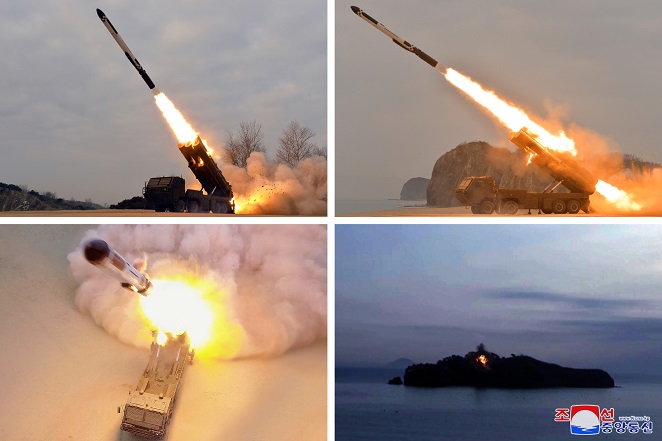
This composite photo, released by North Korea’s official Korean Central News Agency, shows a long-range cruise missile being test-fired on Jan. 25, 2022. (Yonhap)
The North’s official Korean Central News Agency (KCNA) stressed Monday that the Hwasong-12 missile is “being produced and deployed” — an indication that it has completed its operational deployment following its 2017 claim to have completed its development.
The KCNA also released images of its liftoff from a mobile launcher and flight during the boost phase, as well as those of the Earth taken in space. The images appear to have been taken by drones and a camera installed in the payload.
Pyongyang also conducted self-proclaimed hypersonic missile tests on Jan. 5 and 11 following the first such test last September.
“Through the development of weapons, the North appears to have boosted the morale of its people when the country as a whole is grappling with worsening economic hardships in the midst of the COVID-19 pandemic,” the security expert said.
“It’s a typical pattern in which the North highlights external threats to reinforce internal cohesion, engages in provocations and then utilizes subsequent international sanctions to underscore the threats from without,” he added.
The North’s apparent move to brinkmanship comes in the lead-up to the country’s major holidays when there is an apparent political imperative for the regime to instill a sense of pride into its citizens struggling with ever-worsening economic travails.
“Pyongyang also wants to boost national pride as it gears up to celebrate political anniversaries in the context of economic struggles,” Leif-Eric Easley, associate professor of international studies at Ewha Womans University, said.
Domestic factors have emerged as a crucial variable in the analysis of motives behind the North’s weapons tests as a set of external elements, including the Beijing Games, had been expected to deter Pyongyang’s military moves.
This month, the North conducted four known rounds of missile tests in sites close to the border with China, although it might be aware Beijing does not want the launches to overshadow the Olympics, especially following the U.S.’ diplomatic boycott of the event.
In particular, the move is a violation of U.N. Security Council resolutions banning any launch using ballistic missile technology, which would force China into joining the global move to consider or roll out new punitive measures against its neighbor.
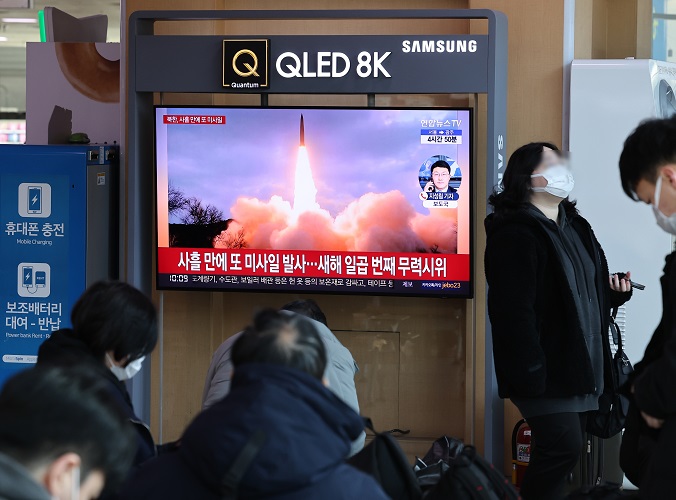
A news report on North Korea’s launch of an intermediate-range ballistic missile is aired on a television at Seoul Station on Jan. 30, 2022. South Korea’s military said the missile flew about 800 kilometers at a top altitude of 2,000 km. (Yonhap)
Observers said the launches close to the border could signal either the North’s possible friction with its patron, China, or Beijing’s acquiescence to the weapons tests.
The North’s missile testing frenzy has also stumped some analysts that had thought Pyongyang could take a wait-and-see stance for the time being as its year-end ruling party plenary did not send any particular message to Seoul and Washington while focusing on chronic food shortages and other domestic issues.
The provocative mode is seen as an ominous sign that the North could further ratchet up tensions with more powerful weapons tests as it issued a thinly veiled threat on Jan. 20 to lift a voluntary moratorium on nuclear and ICBM tests declared in April 2018.
Park Won-gon, professor of North Korean studies at Ewha Womans University, said that the test of the latest IRBM potentially capable of delivering a tactical nuclear warhead could mark a culmination of the North’s decadeslong drive for nuclear armament.
“The nuclear-tipped IRBM and other missiles could keep South Korea, Japan and even Guam hostage, and lead to a situation in which the removal of such tactical arms becomes impossible, meaning the North cannot help but be viewed as a de facto nuclear power,” Park said.
“Then would come the next stage of nuclear arms restrictions (between the U.S. and the North) rather than the North’s denuclearization,” he added.
For South Korean President Moon Jae-in, the North’s escalatory military actions mean a major blow to his peace initiative where he has put much political capital.
But those actions might have served as a sobering reminder for the Joe Biden administration whose repeated dialogue offers to the North have started to be taken with a grain of salt or written off as perfunctory, observers noted.
(Yonhap)




